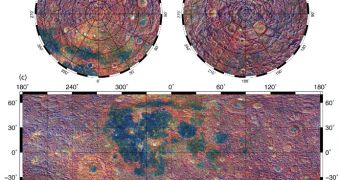Over the past 4 and a half billion years, the Moon has suffered tremendous damage from space impactors and internal processes, acting like a true shield for Earth in the process. The scars it carries to prove this now also provide insight into some of the processes that shape its surface.
These are the same processes that were at work when the satellite was very young, and they still go on to this day, planetary scientists say. In the past, they add, the Moon had an active interior that triggered the formation of volcanoes on its surface.
With modern advancements in spacecraft technology, experts are now able to analyze a new series of maps showing the roughness and slopes of the lunar surface. They hope that doing so will provide them with more insight into how the Moon was shaped over the eons.
Experts with the California Institute of Technology (Caltech), in Pasadena, California, are currently studying the first comprehensive set of such maps. The charts were compiled using data collected by the NASA Lunar Reconnaissance Orbiter (LRO).
The LRO Lunar Orbiter Laser Altimeter (LOLA) instrument was essential to collecting all the datasets, the investigators say. Both the orbiter and the instrument were designed, developed and built at the NASA Goddard Space Flight Center (GSFC), in Greenbelt, Maryland.
The research team, led by Caltech expert Meg Rosenburg, published the results of its latest study in a recent issue of the renowned Journal of Geophysical Research. The scientist was the first author of the paper.
She explains that the roughness of craters and other features on the lunar surface can be used to determine the landscape features' age. This can in turn provide more clues as to what caused them.
“The key is to look at the roughness at both long and short scales. Old and young craters have different roughness properties – they are rougher on some scales and smoother on others,” she goes on to say.
The original shape of an impact crater, for example, changes over time, due to processes such as erosion, or when the site is impacted by other meteorites or asteroids. Their edges become what experts refer to as softened, in the sense that they are no longer well delimited form the surrounding areas.
“Because this softening of the terrain hasn't happened at the new impact sites, the youngest craters immediately stand out,” GSFC LOLA co-investigator Gregory Neumann explains.
“It is remarkable that the Moon exhibits a great range of topographic character: on the extremes, surfaces roughened by the accumulation of craters over billions of years can be near regions smoothed and resurfaced by more recent mare volcanism,” concludes Caltech researcher Oded Aharonson.

 14 DAY TRIAL //
14 DAY TRIAL //